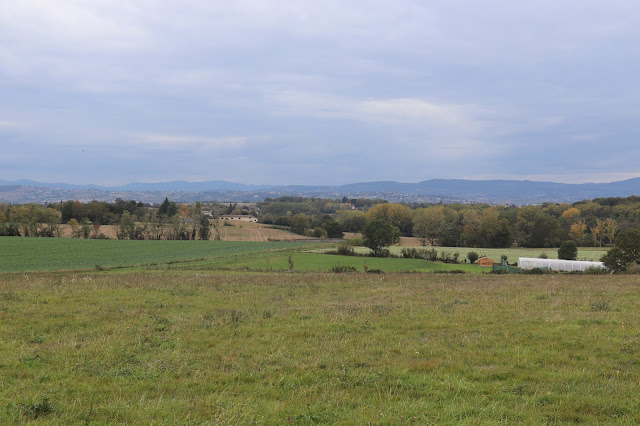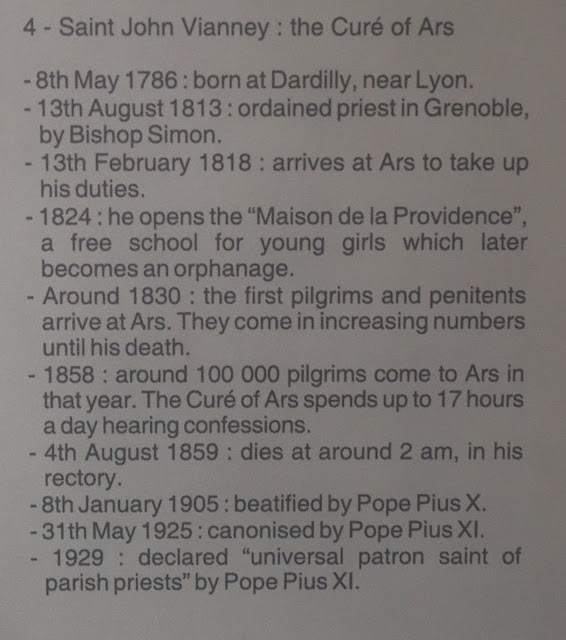St John Mary Vianney was born on 8 May 1786, in the French town of Dardilly, France (near Lyon), and was baptized the same day. His parents, Matthieu and Marie had six children, of whom John was the fourth. The Vianneys were devout Catholics who helped the poor and gave hospitality.
By 1790, the anticlerical Terror phase of the French Revolution forced many loyal priests to hide from the regime in order to carry out the sacraments in their parish. Even though to do so had been declared illegal, the Vianneys traveled to distant farms to attend Masses celebrated by priests on the run. Realizing that such priests risked their lives day by day, Vianney began to look upon them as heroes. He received his First Communion catechism instructions in a private home by two nuns whose communities had been dissolved during the Revolution. He made his First Communion at the age of 13. During the Mass, the windows were covered so that the light of the candles could not be seen from the outside. His practice of the faith continued in secret, especially during his preparation for confirmation.
The Catholic Church was re-established in France in 1802 by Napoleon Bonaparte, resulting in religious peace throughout the country. When his future vocation and longed for an education. He was 20 when his father allowed him to leave the farm to be taught at a "presbytery-school" in the neighboring village of Écully, conducted by Abbé Balley. The school taught arithmetic, history, geography and Latin. Vianney struggled with school, especially with Latin, since his past education had been interrupted by the French Revolution. Only because of Vianney's deepest desire to be a priest—and Balley's patience—did he persevere.
His studies were interrupted in 1809 when he was drafted into Napoleon's armies. He would have been exempt, but Napoleon had withdrawn the exemption in certain dioceses because of his need for soldiers in his fight against Spain. Two days after he had to report at Lyons, he became ill and was hospitalized, during which time his draft left without him. Once released from the hospital, on 5 January, he was sent to Roanne for another draft. He went into a church to pray, and fell behind the group. He met a young man who volunteered to guide him back to his group, but instead led him deep into the mountains of Le Forez, to the village of Les Noes, where deserters had gathered. Vianney lived there for fourteen months, hidden in the byre attached to a farmhouse, and under the care of Claudine Fayot, a widow with four children. He assumed the name Jerome Vincent, and under that name, he opened a school for village children. Since the harsh weather isolated the town during the winter, the deserters were safe from gendarmes. However, after the snow melted, gendarmes came to the town constantly, searching for deserters. During these searches, Vianney hid inside stacks of fermenting hay.
An imperial proclamation in March 1810 granted amnesty to all deserters, enabling Vianney to go back legally to Écully, where he resumed his studies. He was tonsured in 1811, and in 1812 he went to the minor seminary at Verrières-en-Forez. In autumn of 1813, he was sent to the major seminary at Lyons. Considered too slow, he was returned to Abbé Balley. However, Balley persuaded the Vicar general that Vianney's piety was great enough to compensate for his ignorance, and he was ordained a deacon in June 1815, and was ordained priest on 12 August 1815 and was appointed the assistant to Balley in Écully.
In 1818, shortly after the death of Balley, Vianney was appointed parish priest of the parish of Ars, a town of 230 inhabitants. On his way he got lost trying to find the town. Providentially, a shepherd boy by the name of Antoine Givre caught sight of him. After they greeted one another, Vianney told Antoine that he was on his way to Ars and he was lost. Antoine pointed him in the right direction and walked with him into the small town of about 200 people.As the story is told, the future saint said to Antoine upon their arrival, “You have shown me the way to Ars - I will show you the way to heaven.”
The French Revolution had resulted in religious ignorance and indifference, due to the devastation wrought on the Catholic Church in France. At the time, Sundays in rural areas were spent working in the fields, or dancing and drinking in taverns. He spent time in the confessional and gave homilies against blasphemy and paganic dancing. If his parishioners did not give up this dancing, he refused them absolution.
The Curé came to be known internationally, and people from distant places began travelling to consult him as early as 1827. By 1855, the number of pilgrims had reached 20,000 a year. During the last ten years of his life, he spent 11 or 12 hours a day in the confessional during winter, and up to 16 in the summer.
He lived an incredibly simple life, he had insight into people's souls, and he was a prolific visitor. People flocked to him for advice. One such person was the mother of Suzanne Aubert. She took her daughter to see him as she and her husband had arranged her marriage to the son of a family friend. Suzanne refused to comply. Her mother sought the support of the much-respected John Vianney, who instead told Suzanne that she had made the right decision. God had other designs for her, he said. It was this encouragement she needed. Please God she will be New Zealand's first saint.
 |
| The French countryside around Ars |
 |
| Ars today |
 |
| The house where he lived |
 |
| His first bedroom |
 |
| And later bedroom where he died |
 |
| The basilica at Ars |
 |
| The shrine with his body |
 |
| I celebrated Mass at the altar he used in Ars and offered the Mass for our priests and seminarians and more vocations for the Diocese of Hamilton |
On 4 August 1859, John Vianney died at the age of 73. The bishop presided over his funeral with 300 priests and more than 6,000 people in attendance. Before he was buried, Vianney's body was fitted with a wax mask.
In 1925 John Mary Vianney was canonized by Pope Pius XI, who in 1929 made him patron saint of parish priests.
St John Vianney, pray for us








No comments:
Post a Comment